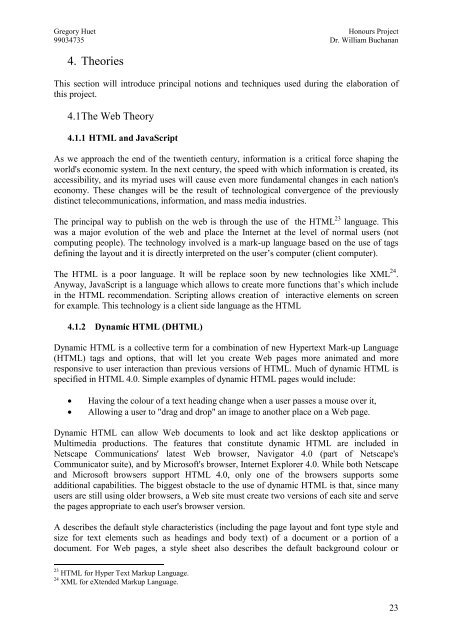Honours Project: - Napier University
Honours Project: - Napier University
Honours Project: - Napier University
Create successful ePaper yourself
Turn your PDF publications into a flip-book with our unique Google optimized e-Paper software.
Gregory Huet<br />
<strong>Honours</strong> <strong>Project</strong><br />
99034735 Dr. William Buchanan<br />
4. Theories<br />
This section will introduce principal notions and techniques used during the elaboration of<br />
this project.<br />
4.1 The Web Theory<br />
4.1.1 HTML and JavaScript<br />
As we approach the end of the twentieth century, information is a critical force shaping the<br />
world's economic system. In the next century, the speed with which information is created, its<br />
accessibility, and its myriad uses will cause even more fundamental changes in each nation's<br />
economy. These changes will be the result of technological convergence of the previously<br />
distinct telecommunications, information, and mass media industries.<br />
The principal way to publish on the web is through the use of the HTML 23 language. This<br />
was a major evolution of the web and place the Internet at the level of normal users (not<br />
computing people). The technology involved is a mark-up language based on the use of tags<br />
defining the layout and it is directly interpreted on the user’s computer (client computer).<br />
The HTML is a poor language. It will be replace soon by new technologies like XML 24 .<br />
Anyway, JavaScript is a language which allows to create more functions that’s which include<br />
in the HTML recommendation. Scripting allows creation of interactive elements on screen<br />
for example. This technology is a client side language as the HTML<br />
4.1.2 Dynamic HTML (DHTML)<br />
Dynamic HTML is a collective term for a combination of new Hypertext Mark-up Language<br />
(HTML) tags and options, that will let you create Web pages more animated and more<br />
responsive to user interaction than previous versions of HTML. Much of dynamic HTML is<br />
specified in HTML 4.0. Simple examples of dynamic HTML pages would include:<br />
• Having the colour of a text heading change when a user passes a mouse over it,<br />
• Allowing a user to "drag and drop" an image to another place on a Web page.<br />
Dynamic HTML can allow Web documents to look and act like desktop applications or<br />
Multimedia productions. The features that constitute dynamic HTML are included in<br />
Netscape Communications' latest Web browser, Navigator 4.0 (part of Netscape's<br />
Communicator suite), and by Microsoft's browser, Internet Explorer 4.0. While both Netscape<br />
and Microsoft browsers support HTML 4.0, only one of the browsers supports some<br />
additional capabilities. The biggest obstacle to the use of dynamic HTML is that, since many<br />
users are still using older browsers, a Web site must create two versions of each site and serve<br />
the pages appropriate to each user's browser version.<br />
A describes the default style characteristics (including the page layout and font type style and<br />
size for text elements such as headings and body text) of a document or a portion of a<br />
document. For Web pages, a style sheet also describes the default background colour or<br />
23 HTML for Hyper Text Markup Language.<br />
24 XML for eXtended Markup Language.<br />
23










![Unit 5. Switches and VLANs [PDF]](https://img.yumpu.com/34422504/1/184x260/unit-5-switches-and-vlans-pdf.jpg?quality=85)





